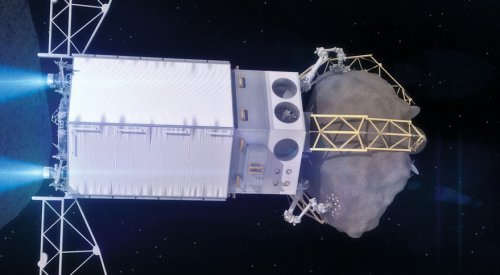WASHINGTON — A fiscal year 2018 budget proposal released by the Trump administration March 16 would cancel NASA’s Asteroid Redirect Mission (ARM) and several Earth science programs, but spares NASA the deeper cuts proposed for many other agencies.
The budget blueprint document, an outline of the administration’s budget request but with only limited details, requests $19.1 billion for NASA, a cut of about one percent from the $19.285 billion the agency received in fiscal year 2016. NASA, like other government agencies, is currently operating under a continuing resolution that funds programs at 2016 levels.
Targeted for cancellation in the budget proposal is ARM, a NASA program to fly a robotic spacecraft to a near Earth object, retrieve a boulder from its surface and fly back to lunar orbit, where astronauts would visit it on a future Orion mission. ARM has enjoyed lukewarm support, at best, in Congress, with many members expressing opposition to a mission they claim does not support long-term exploration goals.
The budget document does not provide details about the reason for cancelling ARM beyond to “accommodate increasing development costs” in exploration programs. The document said that the Space Launch System, Orion and associated ground systems would get $3.7 billion in 2018, an amount similar to what those programs collectively received in 2016.
The budget proposal provides $1.8 billion for Earth science programs, a cut of about five percent from what NASA received in 2016. It specifically targets four planned or ongoing missions for termination: the Plankton, Aerosol, Cloud, ocean Ecosystem (PACE) satellite, the Climate Absolute Radiance and Refractivity Observatory (CLARREO) Pathfinder and the Orbiting Carbon Observatory (OCO) 3 instruments for the International Space Station, and “DSCOVR Earth-viewing instruments,” an apparent reference to Earth observation instruments on the Deep Space Climate Observatory (DSCOVR), launched in 2015.
The blueprint didn’t explain why these missions were targeted for elimination. In NASA’s fiscal year 2017 budget request, it projected spending in fiscal year 2018 $27.9 million on CLARREO Pathfinder, $9.5 million on OCO-3 and $1.2 million on DSCOVR. No budget was provided for PACE, a mission still in early phases of development and not planned for launch until the early 2020s. The blueprint noted additional cost reductions would come from cuts in research grant programs.
The budget proposal also seeks to eliminate NASA’s Office of Education, which received $115 million in 2016. “The Office of Education has experienced significant challenges in implementing a NASA-wide education strategy and is performing functions that are duplicative of other parts of the agency,” the document stated.
One area getting a budget increase is NASA’s planetary science program, which would receive $1.9 billion in the administration’s request, up from $1.63 billion in 2016. The document specifically mentions support for the Mars 2020 rover mission and the Europa Clipper mission.
However, the budget proposal provides no funding for a proposed Europa lander mission, still in concept development, in order to “preserve the balance of NASA’s science portfolio and maintain flexibility to conduct missions that were determined to be more important by the science community.”
Mick Mulvaney, director of the White House’s Office of Management and Budget, alluded to the lack of funding for a Europa lander mission in a briefing with reporters March 15. “I think we changed one of the missions to a moon at Saturn or Jupiter, but I can’t remember the details on that,” he said. Europa is a moon of Jupiter.
In space technology, the budget proposal “restructures” RESTORE-L, a satellite servicing program that received $133 million in fiscal year 2016. The administration called RESTORE-L “duplicative” and said that restructuring would “reduce its cost and better position it to support a nascent commercial satellite servicing industry,” saving $88 million over 2016 levels.
The proposal provided few other fiscal details about the budget proposal, including a breakout of spending by budgetary account with NASA. The blueprint document said that its proposal “creates new opportunities for collaboration with industry” on a variety of programs, from International Space Station operations to data purchase programs for companies operating small satellite constellations, but offered no specifics about those initiatives.
Despite the cut to some NASA programs, the overall effect on the agency is relatively minor compared to others. The budget proposal makes much deeper cuts at other agencies, including a 31 percent reduction at the Environmental Protection Agency and 28 percent cut at the State Department.
The Commerce Department, which includes the National Oceanic and Atmospheric Administration, would see its overall budget cut by 16 percent in the proposal. The document doesn’t provide specific figures for NOAA, but states that the budget “maintains the development” of the Joint Polar Satellite System (JPSS) and Geostationary Operational Environmental Satellite (GOES) weather satellite programs. However, the budget would take savings from the Polar Follow On program, which funds development of future JPSS satellites after JPSS-2, “by better reflecting the actual risk of a gap in polar satellite coverage.”
NASA, Mulvaney suggested at the briefing, was a priority for the Trump administration and thus spared the deeper cuts other agencies received. “Space exploration is part of his priorities,” he said of the president.
A full budget proposal, with spending details for all federal programs, will be released by early May.
Share with your friends

(0) Comments
This article comments are currently no :(